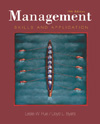 |  Management: Skills and Application, 10/e Leslie W Rue,
Georgia State University - Emeritus
Lloyd L Byars,
Georgia Institute of Technology
Developing Communication Skills
Chapter Summary| 1. Define communication. Communication is the act of transmitting information.
2. Describe the interpersonal communication process. Interpersonal communication occurs between individuals. It is an interactive process that involves a person's effort to attain meaning and respond to it. It involves sending and receiving verbal and nonverbal messages.
3. Describe problems that could arise from conflicting or inappropriate assumptions made in interpersonal communication. Misunderstandings can occur when a speaker thinks he or she was being clear or was understood. Questions that go unanswered, points that are misunderstood, and meanings that are misinterpreted are examples of potential problems.
4. Define semantics, and explain its role in interpersonal communication. Semantics is the science or study of the meanings of words and symbols. Because of the possibility of misinterpretation, words must be carefully chosen and clearly defined to enable effective communication.
5. Define perception. Perception deals with the mental and sensory processes an individual uses in interpreting information received.
6. Explain how emotions may affect communication. Emotions affect one's disposition to send and receive communication. Anger, joy, fear, sorrow, disgust, or panic can all affect the way one sends and receives messages. Communications during periods of high emotion are often subject to distortion.
7. Explain the concept of feedback in communication. Feedback is the flow of information from the receiver to the sender. For communication to be effective, information must flow back and forth between sender and receiver.
8. Explain active listening. Active listening involves absorbing what another person is saying and responding to the person's concerns.
9. Describe the grapevine. The grapevine consists of the informal channels of communication that develop within the organization as a result of common hobbies, home towns, lunch breaks, family ties, and social relationships among employees.
10. Define and briefly discuss the e-mail process. The electronic mail, or e-mail, system provides for high-speed exchange of written messages through the use of computerized text processing and computer-oriented communication networks.
11. Discuss two factors that complicate communications in international business activities. Communicating in a foreign language complicates the communication process. Cultural differences exhibited through nonverbal communications are also complicating factors. |
|



 2003 McGraw-Hill Higher Education
2003 McGraw-Hill Higher Education